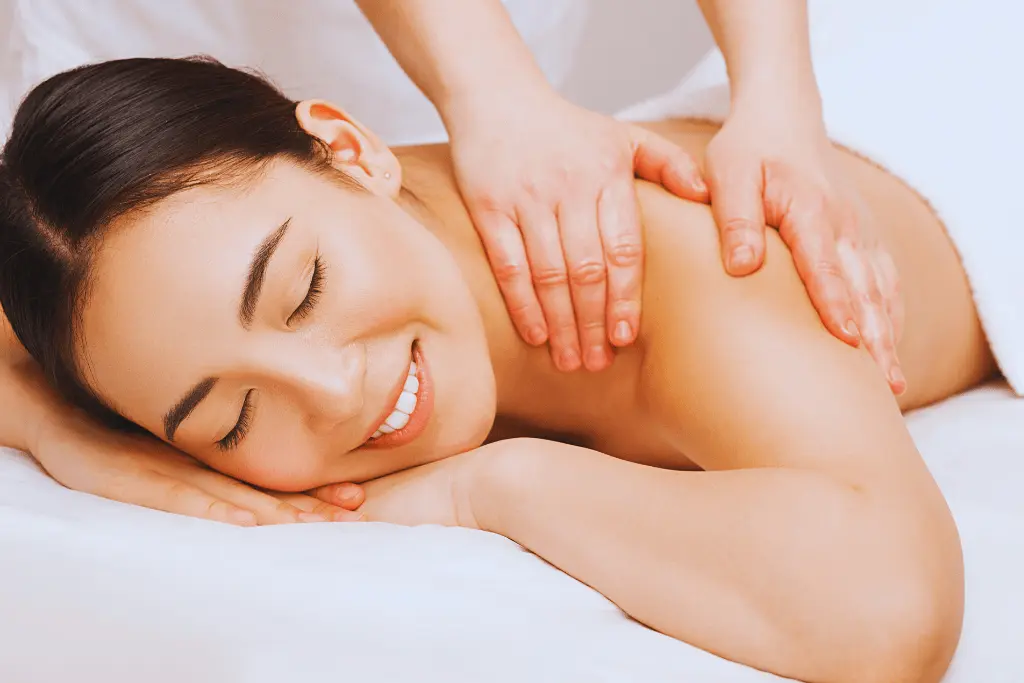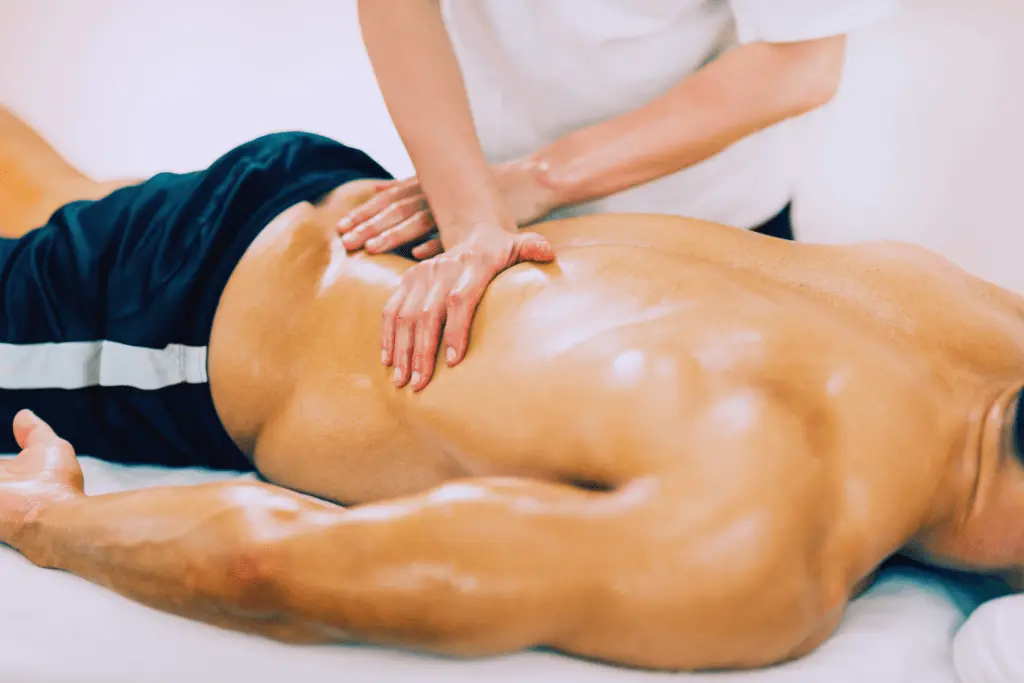Our backs take a beating every day. From hunching over laptops to carrying heavy groceries, it’s no wonder back pain is so common. A back massage can be both soothing and effective.
This guide is your go-to resource for everything about back massage technique.
We’ll cover:
- The benefits of massage, from relaxation to pain relief
- How massage can target different types of back pain
- Techniques like Swedish massage and trigger point therapy
Whether you want to visit a professional back massage therapist or give a relaxing back rub at home, this guide has you covered.
Learn the best ways to ease back tension and enjoy a healthier, more comfortable you!
What Does a Back Massage Do?
A back massage does more than feel good. It eases tension and stiffness in muscles. It helps your body and mind. Regular massages can reduce pain, improve posture, and increase flexibility. They also boost circulation and relax tight knots.
Back massages help you recover from stress or minor injuries. They calm the nervous system and reduce fatigue. Whether done by a professional or at home, they make you feel relaxed and energized. Regular sessions support overall wellness and keep you moving comfortably.
Benefits of a Back Massage
Physical Benefits
A back massage works directly on muscles and tissues. It eases stiffness, soreness, and tension from daily activities or injuries.
- Reduces muscle tension, spasms, and inflammation
- Helps with arthritis or sciatica
- Boosts blood flow and speeds healing
- Relaxes tight muscles and eases stiffness
- Improves joint flexibility
- Aids recovery after exercise
These benefits help you move better and feel less discomfort. Over time, massages can prevent injuries and keep you active.
Mental Benefits
Back massages also calm the mind. They reduce stress, improve mood, and promote relaxation.
- Lowers cortisol and boosts serotonin and dopamine
- Encourages calm and relaxation
- Helps improve sleep quality
- Enhances overall well-being
Combining physical relief with mental calmness, back massages are great for your health.

Types of Back Massage
Back massages can range from gentle relaxation to deep tissue work. Common types include Swedish, deep tissue, and hot stone massage, each targeting different needs. Other options include Shiatsu, Thai, Trigger Point, prenatal, and chair massages.
Here’s a closer look at popular types:
- Swedish Massage: Gentle strokes, kneading, and circular movements. Great for relaxation and circulation. Perfect for beginners or those who prefer a lighter touch.
- Deep Tissue Massage: Focuses on deeper muscles and connective tissue. Releases chronic tension and knots, making it a vital component of massage therapy. Often used for specific pain or injuries.
- Hot Stone Massage: Heated stones are placed on the back and used to massage muscles. Eases tension, soothes soreness, and improves circulation.
- Shiatsu Massage: Japanese technique using finger pressure on energy points. Relieves tension and promotes healing. Often done fully clothed.
- Thai Massage: Combines assisted stretching and massage. Improves flexibility and releases full-body tension. Usually done fully clothed.
- Trigger Point Massage: Targets specific tight spots that can cause pain elsewhere. Helps relieve localized discomfort.
- Prenatal Massage: Gentle massage for pregnant women. Relieves back pain and pregnancy-related discomfort.
- Chair Massage: A convenient way to receive a massage that targets specific areas. Short, focused massage in a massage chair. Targets back, shoulders, and neck. Convenient for quick relief.
Choosing the right massage depends on your needs and preferences. A qualified massage therapist can guide you to the best type for your situation.
How to Give a Back Massage
A back massage relaxes muscles and eases tension. You don’t need to be an expert to help someone feel better.
Setting the Scene
- Location: Pick a quiet, warm, private space.
- Ambiance: Use dim lights, candles, or essential oils.
- Music: Play soft, calming music.
- Comfort: Make sure the massage surface is soft. Use pillows or towels for support.
Tools You Need for Massage Therapy
- Massage Oil or Lotion: Helps hands glide and nourishes skin.
- Towels: Cover areas not being massaged. Wipe off extra oil.
- Optional: Hot towels, massage stones, or a heating pad for extra comfort.
Basic Massage Techniques
Preparing the Back
- Apply oil with broad, gentle strokes. Warm up the muscles.
Compression
- Press muscles rhythmically without sliding.
- Use palms or a soft fist. Hold a few seconds, then release.
- Good for warming up muscles and easing tension, this technique is often used in professional massage settings.
Gliding (Effleurage)
- Long, smooth strokes along the muscles.
- Move toward the heart.
- Spreads oil, warms tissue, and relaxes muscles.
Kneading (Petrissage)
- Lift, squeeze, and roll the muscles.
- Use thumbs, fingers, or palms to effectively give a back massage that targets specific tension areas.
- Works well for deep tension and knots.
Step-by-Step Massage
Opening
- Start with gentle Effleurage to warm up the back.
Main Massage
- Back & Shoulders: Use Effleurage and Petrissage on large muscles.
- Lower Back: Massage around muscles. Avoid the spine.
- Neck & Shoulders: Focus on tight areas.
Closing
- End with light Effleurage to relax the recipient completely.
Lower Back Self Massage
This self-massage works well for relieving lower back pain. No equipment is needed.
Steps to Follow
- Sit on the floor with your legs crossed. Keep your back straight.
- Place your thumbs on each side of the sacrum, the triangular bone at the bottom of your spine.
- Move your thumbs in small circular motions, working up and down the sacrum.
- Apply gentle pressure on tense spots to effectively release tension during the massage. Pause, then release.
- Continue as needed, and remember to breathe deeply.
- You can also watch video tutorials on YouTube for guidance.
Chair Option
- Sit in a chair with your feet flat on the floor.
- Keep your back straight and upright.
- Use your thumbs or fingers to massage your lower back in small circular motions.
This simple self-massage helps relieve tension, improve blood flow, and reduce discomfort in your lower back.

Tips for How to Give a Good Back Massage
A good back massage helps relieve tension and promotes relaxation. Follow these tips for a soothing and effective experience:
- Use your body weight: Apply pressure with your palms, forearms, and even your body weight instead of straining your thumbs or fingers.
- Check for tension: Feel for knots or tight spots before starting. Focus extra attention on these areas.
- Vary your strokes: Mix long strokes, kneading, circular motions, and gentle percussion to reach different muscle layers.
- Encourage deep breathing: Ask the recipient to breathe slowly and deeply. This helps muscles relax and allows deeper pressure.
- Use massage oil or lotion: Reduces friction and lets your hands glide smoothly over the skin.
- Monitor pressure: Ask often if the pressure is comfortable. Adjust for different areas as needed.
- Cover all areas: Massage along the spine and sides of the back for a complete treatment.
- Keep your hands warm: Rub your hands together periodically to prevent cold hands from causing discomfort.
- Stay hydrated: Sip water before and during the massage to avoid fatigue.
- Finish gently: End with long, soft effleurage strokes along the direction of blood flow to leave the person’s back relaxed after the massage.
What are the most effective points to massage to relax the back?
To relax your back, focus on key muscle groups and pressure points that hold tension. Massaging these areas can release knots, improve blood flow, and reduce pain, making it an essential part of massage therapy.
Most effective points to massage:
- Upper back (trapezius): This area can greatly benefit from professional massage techniques. The area between your shoulders and neck often stores stress and tightness.
- Shoulder blades (rhomboids): Massaging around the shoulder blades helps release stiffness from long hours of sitting.
- Lower back (erector spinae): Gentle pressure along the spine’s sides can ease tension and improve mobility.
- Spinal base (sacral area): Massaging the lower spine and hips can relieve chronic lower back discomfort.
- Around the spine (paraspinal muscles): Light strokes along the sides of the spine help relax tight back muscles safely.
Focusing on these points regularly can reduce back pain, improve posture, and leave your back feeling lighter and more relaxed.
When giving a full back massage, should you start at the top or bottom, and why?
When giving a full back massage, it’s best to start at the bottom (lower back) and work your way up to the shoulders and neck. Here’s why:
- Improves circulation: Starting at the lower back helps push blood and lymph upward, promoting better circulation throughout the back.
- Relieves tension gradually: The lower back muscles are larger and can handle deeper pressure first, which warms the muscles and prepares them for gentler work higher up.
- Prevents discomfort: Massaging the upper back and neck first can sometimes increase tension in the lower back if it’s left untreated.
- Smooth flow: Moving from bottom to top creates a natural, flowing sequence that makes the massage feel more relaxing and organized.
Tip: Always adjust pressure to comfort, and use long, smooth strokes along the muscles before targeting knots or tight spots.
Relax, Refresh, and Heal with Serenity Head Spa Back Massage
A back massage does more than relax you. It eases tension, reduces pain, and improves overall well-being. Gentle strokes or deep tissue techniques can make you feel lighter and more flexible.
At Serenity Head Spa, we offer personalized back massages. Our skilled therapists focus on your problem areas. They release tight muscles, ease knots, and improve circulation, which is essential in massage therapy. Every massage is tailored to your needs.
We serve beck massage clients in Rockville and Springfield. Whether you have a busy schedule or just need a moment to unwind, we make it easy to feel your best. Regular back massages help prevent stiffness and improve posture.
Leave stress behind by indulging in a self massage or professional massage experience. Boost your energy. Feel renewed, comfortable, and relaxed. Book your session at Serenity Head Spa today.
FAQ about back massage
Q. How can someone massage their own back effectively?
Self-massage can be done using your hands, a tennis ball, or a foam roller. Focus on tight areas like the upper back, shoulder blades, and lower spine. Use gentle pressure and slow, circular motions. Take breaks and avoid pressing directly on the spine.
Q. What Thai massage techniques are helpful for addressing back issues?
Thai massage combines stretching, gentle pulling, and acupressure. Techniques such as spinal mobilization, assisted stretches, and deep pressure along energy lines can relieve tension, improve flexibility, and reduce back pain.
Q. How do kneading, tapping, and deep tissue massage target knots and tension points?
- Kneading: Works in circular motions to soften tight muscles and improve blood flow.
- Tapping (percussion): Stimulates circulation and energizes stiff muscles.
- Deep tissue massage: Applies slow, firm pressure to reach deeper muscle layers, breaking up adhesions and releasing chronic tension.
Q. What are the benefits of deep tissue massage for chronic tension and pain?
Deep tissue massage relieves persistent muscle tightness, reduces stiffness, improves posture, and enhances circulation. It can also decrease pain signals and trigger the release of natural painkillers, helping with long-term relief.
Q. Is it normal to experience pain after a deep tissue back massage, and how long might it last?
Yes, mild soreness or tenderness is normal, especially after the first few sessions. It usually lasts 24–48 hours. Drinking water, stretching gently, and applying heat can help alleviate discomfort.
Q. How does myofascial release therapy (MFR) work for relieving back tension?
MFR targets the fascia, the connective tissue surrounding muscles. Gentle, sustained pressure helps release restrictions, improve mobility, and reduce chronic pain. This therapy is effective for tight or restricted back muscles that don’t respond well to traditional massage alone, demonstrating how massage can help.

